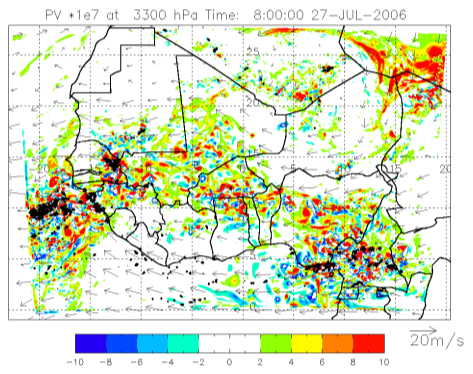Interaction of atmospheric deep convection with the tropical circulation
- Academic lead
- Douglas Parker (Earth and Environment)
- Co-supervisor(s)
- Steve Tobias (Mathematics), Lorenzo Tomassini (Met Office)
- Project themes
- Geophysical and Astrophysical Flows, Underpinning Methods for Fluid Dynamics
This is a mathematical and theoretical project which will explore the relationship between severe storms and large-scale circulation in the atmosphere. The project will exploit the new generation of numerical modelling products, in the form of very high resolution atmospheric simulations with an operational weather prediction model. These model simulations will be used to test and develop mathematical models for the ways in which latent heating in storms, on scales of a few kilometres (individual thunderstorms) influences atmospheric circulations over thousands of kilometres.

Figure 1: Cumulus congestus clouds, and a rare pileus cloud (the “cap” on the congestus) observed in a research flight during the AMMA experiment in 2006. These clouds transport water vapour, momentum and other atmospheric constituents very rapidly through the troposphere. They also release latent heat and moisten the air, pre-conditioning the air for future storms.
Many tropical environments are characterised by widespread fields of cumulonimbus storms. These storms are known to dominate the energy balance of tropical circulations, but we have a poor understanding of their feedbacks with those circulations. We will develop theoretical tools to characterise the cascades of energy and enstrophy from the convective scale (a few km) up to the regional scales (see Fig. 2).
One approach to understanding these processes will be to work with a simple mathematical model of deep atmospheric convection, which we have developed as an extension to the classical Rayleigh-Benard system. This simple “Rainy-Benard” problem shares a number of characteristics seen in real tropical convection, and will allow us to explore the underlying mathematical controls on observed conditions.

Figure 2: A field of potential vorticity caused by many organised cumulonimbus storms, in a model simulation of conditions over West Africa, at 4km resolution. Each storm generates a coherent, but complex pattern of potential vorticity. We aim to understand the influence of these storm-scale patterns on the large-scale circulation.

Figure 3: Time-distance plots of humidity in the Rainy-Benard system, for different values of Rayleigh number. Note the transition from steady convection (a-c) to intermittent convection (d-f).
We have an established partnership with the UK Met Office, and this project will be conducted in collaboration with colleagues at the Met Office. The project will also benefit from links with several UK and international projects in which we are partners; in particular the GCRF African SWIFT project, which is working to improve the science of African weather prediction.
Vallis GK, Parker DJ, Tobias SM. 2019. A Simple System for Moist Convection: The Rainy-Bénard Model. Journal of Fluid Mechanics. 862, pp. 162-199
